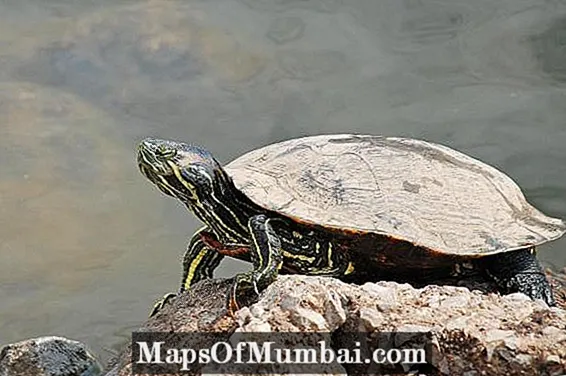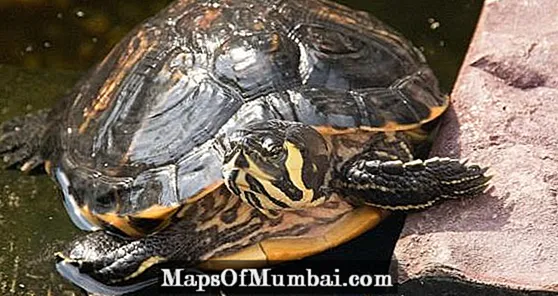
Content
- Red Ear Turtle Habitat
- Red ear turtle in captivity: what is needed?
- How often should the red ear turtle's water change?
- Red Ear Turtle Feeding

When we talk about red ear turtle or yellow ear we are talking about subspecies of Trachemys scripta. This name comes from her typical appearance with yellow or red patches in the auditory region. In addition, they have stripes on the tail and legs.
These turtles can grow to about 40 centimeters and usually females are larger than males. You should take this factor into consideration before deciding to adopt one of these animals. It is possible to keep a turtle in captivity, however, it entails many responsibilities and, for this reason, the Animal Expert will explain to you what are the care of a red ear turtle or yellow.
Red Ear Turtle Habitat
In order to know how to properly care for a red-eared turtle, it is essential that you know what is the habitat natural to her when not in captivity.
These turtles are freshwater species that enjoy slow rivers, lakes and swamps . They can adapt to virtually any aquatic environment, they can even tolerate salt water, even if it is not ideal. Of course, they also enjoy sun exposure, using sand or another surface that allows them to sunbathe.

Red ear turtle in captivity: what is needed?
To adopt a turtle with these characteristics into your home, it is essential to have a quite large aquarium, with a minimum capacity of 290 liters and with a minimum depth of 40-50 cm for the turtle to swim.
In addition, the water temperature it is also important and should be kept all year around 26ºC, although in winter it can be below 20ºC if you want to facilitate hibernation. Regarding the ambient temperature, it should be kept around 30ºC.Please note that turtles kept indoors do not have the need to hibernate, and some veterinarians advise against hibernating in turtles kept indoors due to the risks associated with hibernation if it is not done under ideal conditions and temperature.
If you want your animal to hibernate, you must take some precautions, including a full check-up at the exotic animal veterinarian 1 month before the start of the hibernation period. During the hibernation period, do not turn off the filter or ventilation, just turn off the aquarium heating and lights. Keep the water below 18ºC and consult your veterinarian to assess whether all procedures are correct, as this period is of great sensitivity and a small error can be fatal.
Whether these turtles are indoors or outdoors, they need to be kept in conditions that simulate their natural habitat, with rocks and surfaces at different levels. They must also have a feeding ball and enough sun exposure to grow properly and without health problems. In this sense, it is important to have ramps for the turtle to access the water and land area without any kind of difficulty. Even so, the land area can be composed of plants and trees, although it is recommended to leave an area without vegetation for the turtle to be able to sunbathe. If direct exposure to the sun is not possible, it is essential to use an ultraviolet light lamp. UV-B radiation is essential for the production of Vitamin D, directly involved in calcium metabolism[1]. Correct exposure to these rays, whether through artificial light or directly from the sun, is the key to preventing the most common problems in these animals.
As for environmental enrichment in water, floating plants such as water lilies, bottom plants or some types of algae can be used. But most likely the turtle will devour them. With regard to sand, it is not advisable to use soil for plants or small stones that the turtle can ingest. Opt for common earth or sand and large rocks.
How often should the red ear turtle's water change?
If you have a proper filter and vacuum cleaner, the water can hold up well for two to three months. If you don't have any of these accessories, you will need to change the water every three days.
Confinement to small, completely closed aquariums with no freedom of movement and no sun exposure are totally contraindicated for any type of turtle. These types of conditions are highly conducive to the development of health problems that can even kill the animal.

Red Ear Turtle Feeding
Feeding is an essential point of care you should take with this species of turtle. The diet of these animals in the wild is omnivorous, formed by both plant and animal elements.
The basis of the diet of these turtles can be a specific ration and can be supplemented with animal foods like snails, insects, fish, tadpoles or even meat and fish. A diet based on ration is usually insufficient to meet the nutritional needs of these animals. We must remember that dried prawns should only be provided sporadically and should never be the mainstay of food.
Regarding vegetables, you can include some aquatic plants in the aquarium and offer some fruits and vegetables such as sprouts, peas, bananas, melon and watermelon.
If you've recently adopted a turtle and still haven't found the perfect name for it, check out our list of turtle names.